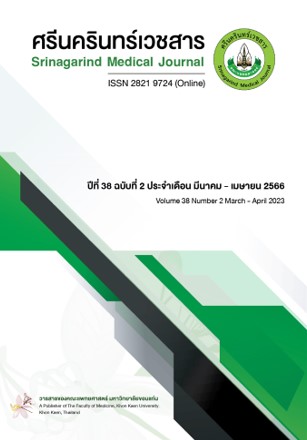พฤติกรรมการบริโภคอาหารของบุคลากร ณ ศูนย์หัวใจสิริกิติ์ ภาคตะวันออกเฉียงเหนือ
คำสำคัญ:
พฤติกรรมการบริโภค, หวาน มัน เค็ม, โรคอ้วนบทคัดย่อ
หลักการและวัตถุประสงค์ : พฤติกรรมการบริโภคอาหารหวาน มัน เค็ม เป็นพฤติกรรมเสี่ยงที่อาจส่งผลให้เกิดภาวะโรคอ้วน (Obesity) และโรคไม่ติดต่อเรื้อรัง (NCD: Non-Communication Disease) จากข้อมูลการตรวจสุขภาพของบุคลากรศูนย์หัวใจสิริกิติ์ฯ ประจำปี พ.ศ. 2564 พบว่า ร้อยละ 32.86 (256 คน) มีภาวะโรคอ้วน การศึกษาครั้งนี้จึงมีวัตถุประสงค์เพื่อศึกษาร้อยละของการบริโภค อาหารหวาน มัน เค็ม ในกลุ่มบุคลากรศูนย์หัวใจสิริกิติ์ฯและเพื่อศึกษาปัจจัยที่มีความสัมพันธ์กับการบริโภคอาหารหวาน มัน เค็ม ในบุคลากร ศูนย์หัวใจสิริกิติ์ฯ
วิธีการศึกษา : การศึกษาเชิงพรรณนาภาคตัดขวาง (cross-sectional descriptive study) เก็บรวบรวมข้อมูลด้วยแบบสอบถามออนไลน์ Google Form จากกลุ่มตัวอย่างจำนวน 102 คน ตั้งแต่ กรกฎาคม ถึง สิงหาคม พ.ศ. 2565 นำข้อมูลที่ได้มาตรวจสอบความถูกต้อง และวิเคราะห์ข้อมูลด้วย IBM SPSS statistics version 28 กำหนดระดับนัยสำคัญทางสถิติที่ระดับ p<0.05
ผลการศึกษา : จากการศึกษา พบว่าอัตราการตอบกลับ ร้อยละ 53.12 กลุ่มตัวอย่างมีพฤติกรรมการบริโภคอาหารหวาน มัน เค็ม 13 คน (ร้อยละ 26.47) และพบว่าปัจจัยด้านช่วงอายุ (OR=0.28: 95%CI, 0.09-0.89, p=0.031) และช่วงรายได้ (OR=0.33: 95%CI, 0.12-0.95 p=0.039) มีความสัมพันธ์กับพฤติกรรมในการบริโภคอาหารหวาน มัน เค็ม
สรุป : กลุ่มตัวอย่างมีพฤติกรรมเสี่ยงในการบริโภคอาหารหวาน มัน เค็ม ร้อยละ 26.47 และพบ 2 ปัจจัยที่มีความสัมพันธ์กับพฤติกรรมการบริโภคหวาน มัน เค็ม ได้แก่ กลุ่มช่วงวัย Generation Y และ Generation Z
มีความเสี่ยงในการบริโภคอาหารหวาน มัน เค็ม มากกว่า กลุ่มช่วงวัย Baby Boomer และ Generation X ถึง 0.72 เท่า เช่นเดียวกับ ผู้ที่มีรายได้สูง มีความเสี่ยงในการบริโภคอาหารหวาน มัน เค็ม มากกว่า ผู้ที่มีรายได้ต่อเดือนน้อย 0.67 เท่า ด้านความพึงพอใจต่อการเข้าถึงอาหารสุขภาพ ควรจัดให้มีการจำหน่ายเครื่องดื่มที่สามารถเลือกระดับความหวาน หรือไม่หวาน ในบริเวณสถานที่ปฏิบัติงานเพิ่มมากขึ้น
เอกสารอ้างอิง
Kongjarern S. Obesity: Silent Killer in the Digital Era. EAU Heritage J Sci Technol 2017;11(3):22-9.
Department of Health Ministry of Public Health. The percentage of overweight and obesity among working age 19-29 years old in each area heath [Internet]. 2022. [cited Jul 9, 2022]. Available from: https://kku.world/575qk
Karnjanapiboonwong A. Report of NCDs situation in 2020 [Internet]. 2020. [cited Jul 9, 2022]. Available from: https://kku.world/8et2l
Institute of Medical Research and Technology Assessment. Clinical practice guidelines for the management of overweight and obesity. 2010:1-4. [cited Mar 1, 2023]. Available from: https://kku.world/63hnk
Sukareechai S. Prevalence of Metabolic Syndrome in personnelat Royal Irrigation Hospital, Nonthaburi Province. Thai J Public Health 2010;40(2):194–204.
Saiphiroonthong W, Choaksuwankij C, Chaimanee A. The Association between Sedentary Work and Obesity among Medical Personnel in Nopparat Rajathanee Hospital. Public Health J Burapha Univ 2015;10(2):34–43.
Human resource division QSHC. Anual health check up report among Queen Sirikit Heart Center of the Northeast staffs in 2022. 2022.
National Statistical Office of Thailand: NSO. Thai national survey of healthcare welfare and food consumption in 2560 [Internet]. 2022. [cited Jul 9, 2022]. Available from: https://kku.world/y48te
Chaitokkia S. Factors affecting food consumption behaviors of adults in northeastern Thailand. Res Dev J Loei Rajabhat Univ 2018;13(45):68–78.
Hudthagosol C. Healthy eating by decrease the consumption of sweet salty and fatty food [Internet]. 2565. [cited Jul 9, 2022]. Available from: https://kku.world/3qufq
Goettler A, Grosse A, Sonntag D. Productivity loss due to overweight and obesity: a systematic review of indirect costs. BMJ Open [Internet]. 2017 [cited Mar 2, 2023];7(10). Available from: https://www.ncbi.nlm.nih.gov/pmc/articles/PMC5640019/ doi.org/10.1136/bmjopen-2016-014632
Thai Health Promotion Foundation. The assessment of sweet salty fatty food consumption [Internet]. 2563 [cited 2022 Jul 9]. Available from: https://kku.world/6ghl8
Thirachit Bunsan. The Importance of Body Mass Index : BMI [Internet]. 2022 [cited Jul 9, 2022]. Available from: https://www.si.mahidol.ac.th/sidoctor/e-pl/admin/article_files/1361_1.pdf
Leecharoen P. Application of Trantheoretical Model Complication Prevention in patients with Chronic disease. Nurs J Minstry Public Health 2014;23(3):1–11.
Sutton K, Logue E, Jarjoura D, Baughman K, Smucker W, Capers C. Assessing Dietary and Exercise Stage of Change to Optimize Weight Loss Interventions. Obes Res 2003;11(5):641–52. doi.org/10.1038/oby.2003.92
Rattanamanee N, Phasunon P. Response rate in quantitative research. J Humanit Soc Sci Thonburi University 2019;13(3):181–8.
Chamnankong K, Kiatadisorn R. Healthy Eating Behavior Patterns of Department of Health Personnel. J Prev Med Assoc Thail 2021;11(2):418–34.
Pudcharakuntana P, Khungtumneam K, Durongritichtichai V. The Factors Associated to the prevalence of Obesity in Adults in Bang Sao Thong Municipality, Samuth Prakan Province. J R Thai Army Nurses 2015;16(2):131–9.
Chatchawarn Paopeng, Suladda Pongutta, Supon Limwattananon,Chulaporn Limwat- tananon, Surasak Chaiyasong, Kanjana Tisayaticom, et al. Food Consumption Behaviors among Different Groups of Thai Population: Do Demographic, Socio-Economic, and Health Status Matter. J Health Sys Res [Internet]. 2560;11(3):316-26. [cited Jul 9, 2022]. Available from: https://kb.hsri.or.th/dspace/bitstream/handle/11228/4779/hsri_journal_v11n3_p316.pdf?sequence=1&isAllowed=y
Kanoknan Somnuk, Kulrut Saytichai, Kittipong Ounkeaw, Rungnapha Siriphonphaibool, Arnon Thongkonghan. Prevalence and Factors Related to Metabolic Syndrome in Personnel of Somdejphrajaotaksinmaharaj Hospital. Vajira Med J J Urban Med 2021;65(1):27–36.
Taweesak Khamlung, Maneerat Theerawiwat, Nirat Imami. Factors associated with stages of change for dietary intake of persons with metabolic syndrome, uthaithani province. J Public Health Nurs 2013;27(3):27–40.
ดาวน์โหลด
เผยแพร่แล้ว
รูปแบบการอ้างอิง
ฉบับ
ประเภทบทความ
สัญญาอนุญาต
ลิขสิทธิ์ (c) 2023 ศรีนครินทร์เวชสาร

อนุญาตภายใต้เงื่อนไข Creative Commons Attribution-NonCommercial-NoDerivatives 4.0 International License.




